

Compact Muon Solenoid
LHC, CERN
| CMS-PAS-SUS-16-047 | ||
| Search for supersymmetry in events with at least one photon, missing transverse momentum, and large transverse event activity in proton-proton collisions at 13 TeV | ||
| CMS Collaboration | ||
| March 2017 | ||
| Abstract: A search for physics beyond the standard model in final states with at least one photon, large transverse momentum imbalance, and large total transverse event activity is presented. This event selection provides good sensitivity for gauge mediated supersymmetry models in which pair-produced gluinos or squarks decay via short-living neutralinos to photons and gravitinos. The data sample corresponds to an integrated luminosity of 35.9 fb$^{-1}$ of proton-proton collisions recorded by the CMS experiment at the LHC in 2016. No excess of events above the standard model background is observed. The data is interpreted in simplified models of gluino- and squark pair production, in which gluinos and squarks decay via gauginos to photons. Gluino masses of up to 2 TeV and squark masses up to 1.6 TeV are excluded. | ||
|
Links:
CDS record (PDF) ;
inSPIRE record ;
CADI line (restricted) ;
These preliminary results are superseded in this paper, JHEP 12 (2017) 142. The superseded preliminary plots can be found here. |
||
| Figures & Tables | Summary | Additional Figures | References | CMS Publications |
|---|
|
Additional information on efficiencies needed for reinterpretation of these results are available here. Additional technical material for CMS speakers can be found here. |
| Figures | |
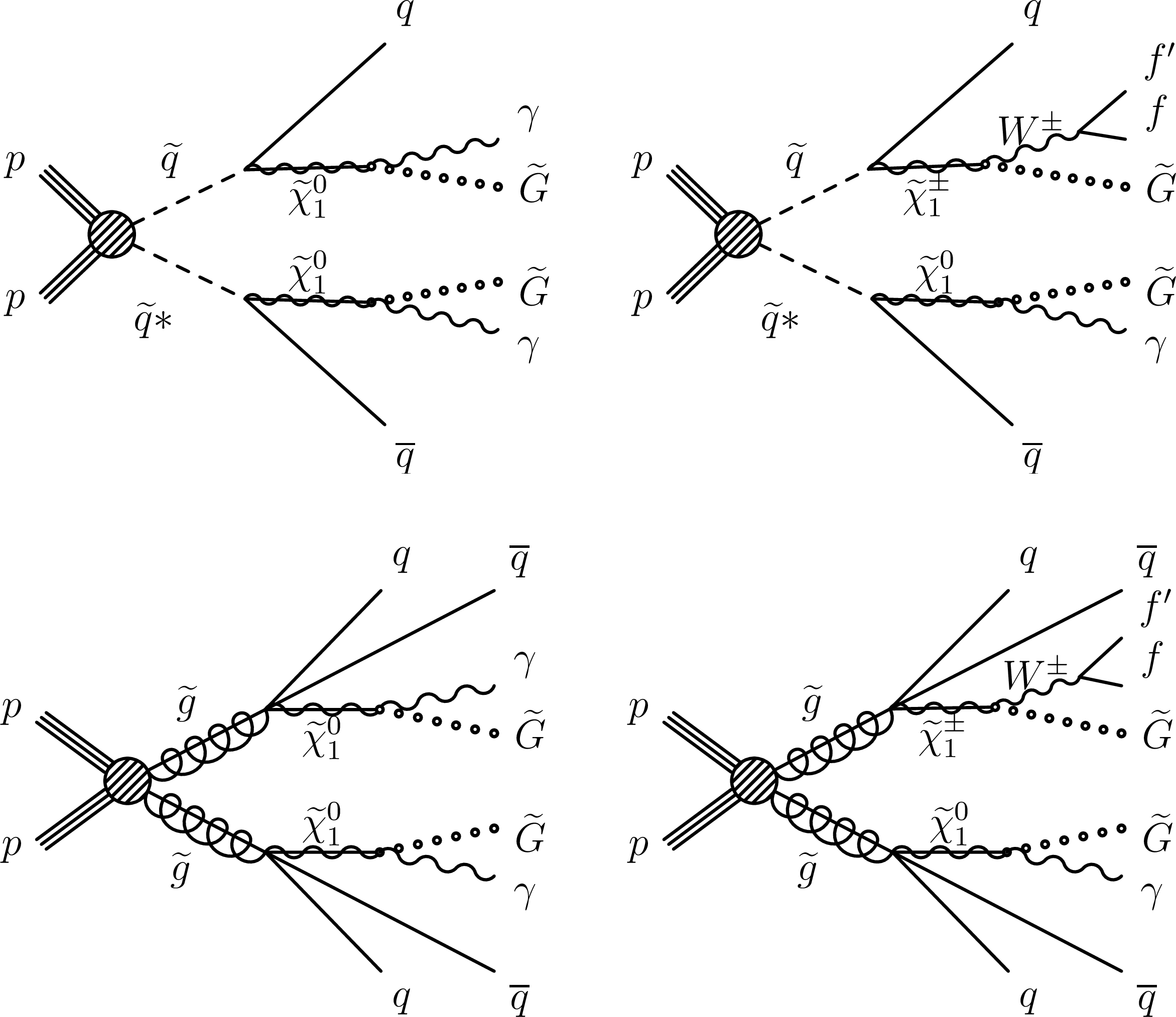
png pdf |
Figure 1:
Feynman diagrams for simulated signal processes: T6gg (top left), T6Wg (top right), T5gg (bottom left) and T5Wg (bottom right). |
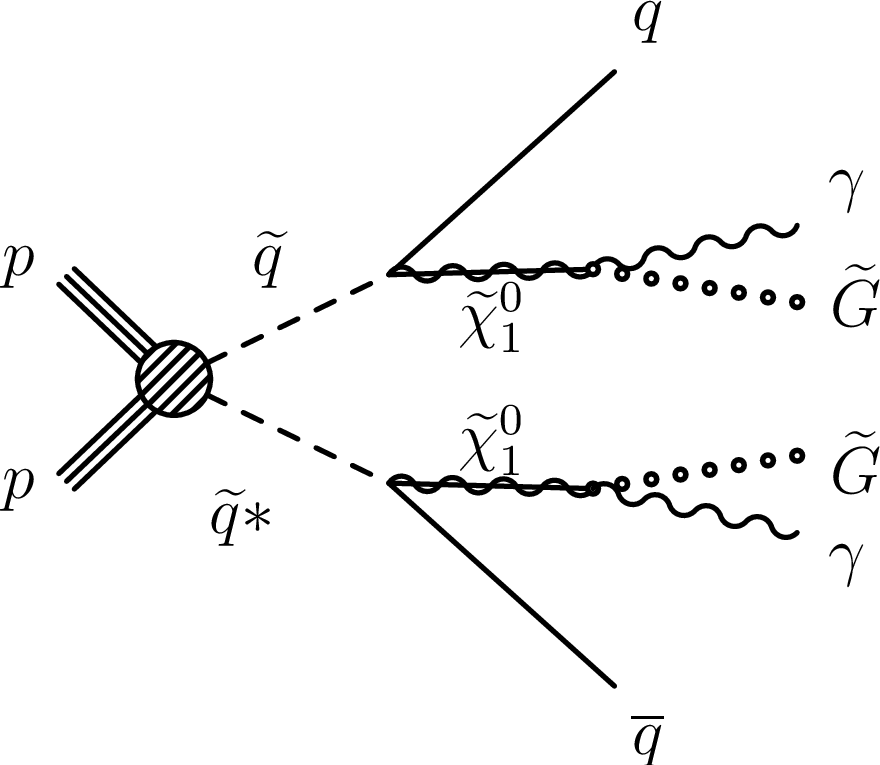
png pdf |
Figure 1-a:
Feynman diagrams for simulated signal processes T6gg. |
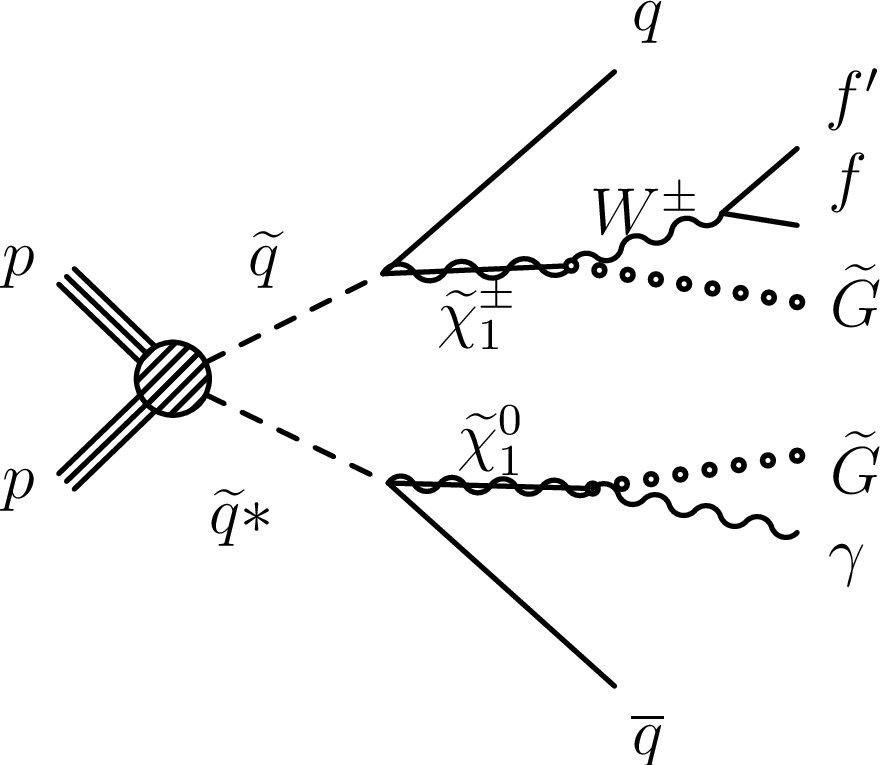
png pdf |
Figure 1-b:
Feynman diagrams for simulated signal processes T6Wg. |
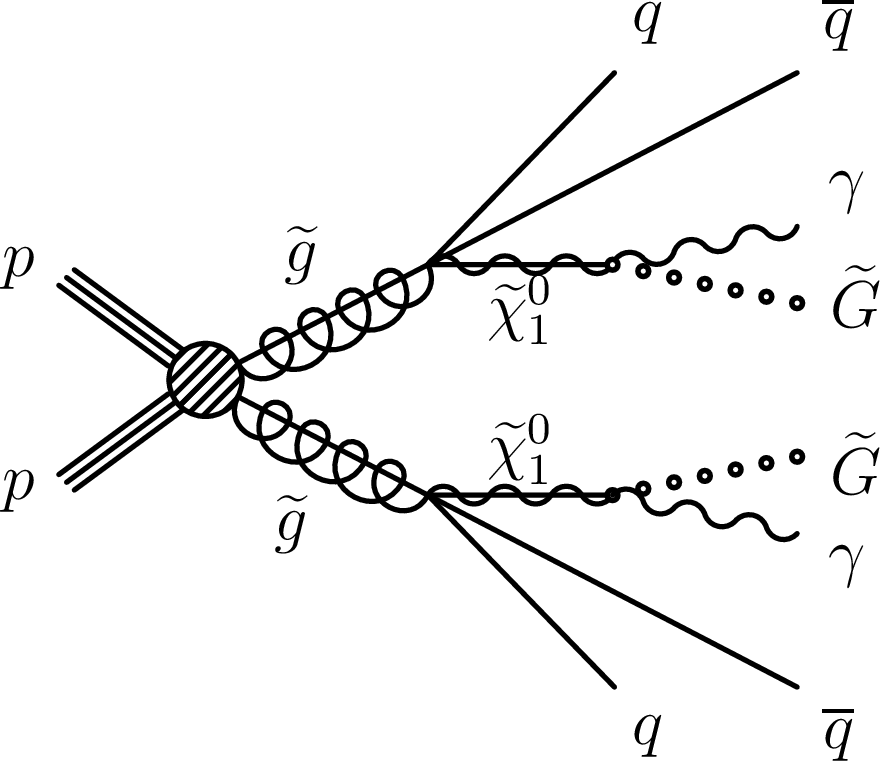
png pdf |
Figure 1-c:
Feynman diagrams for simulated signal processes T5gg. |
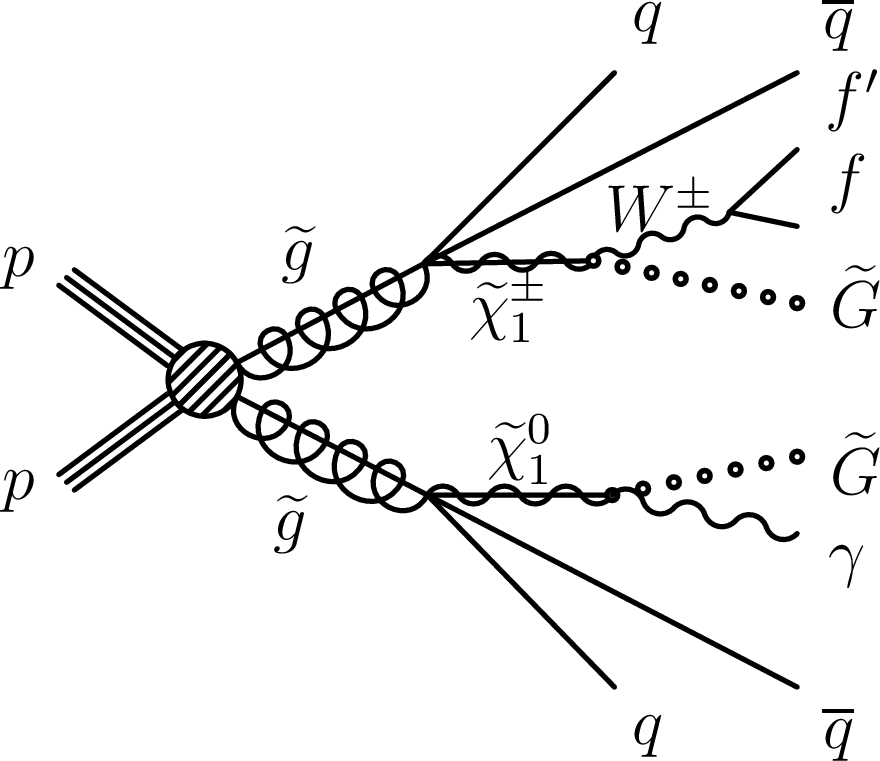
png pdf |
Figure 1-d:
Feynman diagrams for simulated signal processes T5Wg. |

png pdf |
Figure 2:
Validation of the non-genuine ${ {p_{\mathrm {T}}} ^\text {miss}}$ background estimation method with $\gamma$+jets and multijet simulations. The low-$EM{H_{\mathrm {T}}} $ selection is shown on the left, the high-$EM{H_{\mathrm {T}}} $ selection on the right. |
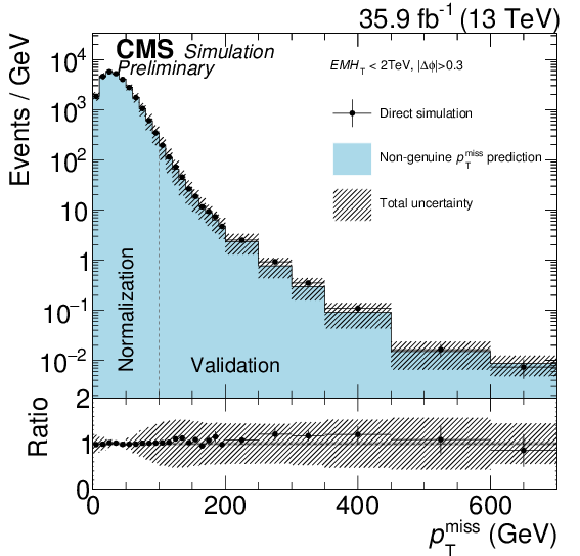
png pdf |
Figure 2-a:
Validation of the non-genuine ${ {p_{\mathrm {T}}} ^\text {miss}}$ background estimation method with $\gamma$+jets and multijet simulations. The low-$EM{H_{\mathrm {T}}} $ selection is shown. |
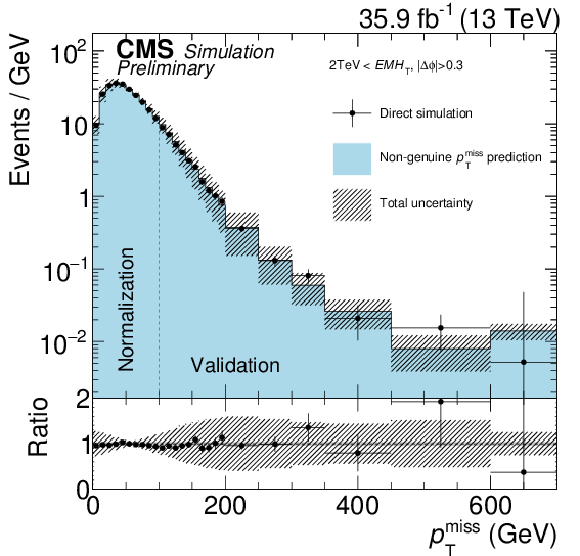
png pdf |
Figure 2-b:
Validation of the non-genuine ${ {p_{\mathrm {T}}} ^\text {miss}}$ background estimation method with $\gamma$+jets and multijet simulations. The high-$EM{H_{\mathrm {T}}} $ selection is shown. |
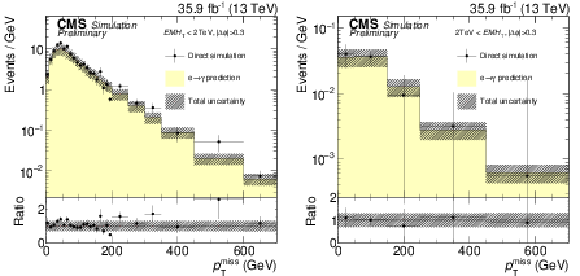
png pdf |
Figure 3:
Validation of the background estimation method for electrons misreconstructed as photons, using W and $ {\mathrm{ t } {}\mathrm{ \bar{t} } } $ simulation. The low-(high-)$EM{H_{\mathrm {T}}} $ selection is shown on the left (right). |
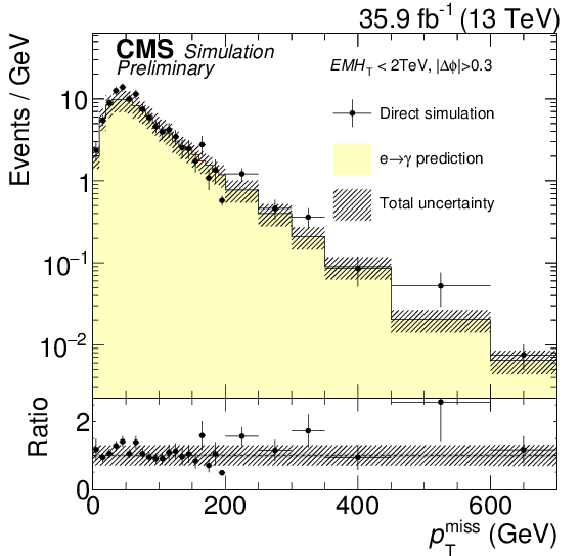
png pdf |
Figure 3-a:
Validation of the background estimation method for electrons misreconstructed as photons, using W and $ {\mathrm{ t } {}\mathrm{ \bar{t} } } $ simulation. The low-$EM{H_{\mathrm {T}}} $ selection is shown. |

png pdf |
Figure 3-b:
Validation of the background estimation method for electrons misreconstructed as photons, using W and $ {\mathrm{ t } {}\mathrm{ \bar{t} } } $ simulation. The high-$EM{H_{\mathrm {T}}} $ selection is shown. |
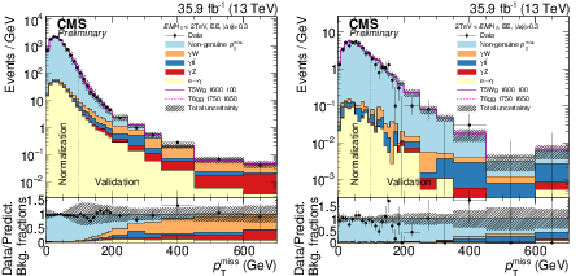
png pdf |
Figure 4:
Validation of the background estimation methods with photons reconsructed in the endcap. The expectation for the T5Wg signal scenario with a gluino mass of 1600 GeV and a gaugino mass of 100 GeV and the T6gg signal scenario with a squark mass of 1750 GeV and a neutralino mass of 1650 GeV are shown added to the background. The low-(high-)$EM{H_{\mathrm {T}}} $ selection is shown on the left (right). Below the $ { {p_{\mathrm {T}}} ^\text {miss}} $ distributions, the data divided by the background prediction are shown as black dots, and the relative background components are shown as colored areas. |
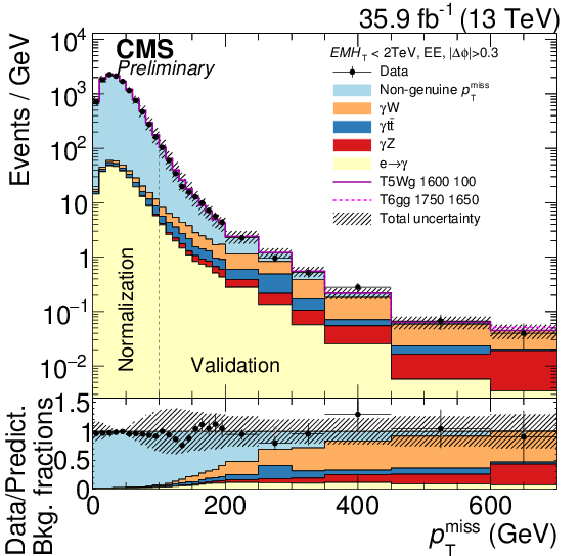
png pdf |
Figure 4-a:
Validation of the background estimation methods with photons reconsructed in the endcap. The expectation for the T5Wg signal scenario with a gluino mass of 1600 GeV and a gaugino mass of 100 GeV and the T6gg signal scenario with a squark mass of 1750 GeV and a neutralino mass of 1650 GeV are shown added to the background. The low-$EM{H_{\mathrm {T}}} $ selection is shown. Below the $ { {p_{\mathrm {T}}} ^\text {miss}} $ distribution, the data divided by the background prediction are shown as black dots, and the relative background components are shown as colored areas. |

png pdf |
Figure 4-b:
Validation of the background estimation methods with photons reconsructed in the endcap. The expectation for the T5Wg signal scenario with a gluino mass of 1600 GeV and a gaugino mass of 100 GeV and the T6gg signal scenario with a squark mass of 1750 GeV and a neutralino mass of 1650 GeV are shown added to the background. The high-$EM{H_{\mathrm {T}}} $ selection is shown. Below the $ { {p_{\mathrm {T}}} ^\text {miss}} $ distribution, the data divided by the background prediction are shown as black dots, and the relative background components are shown as colored areas. |
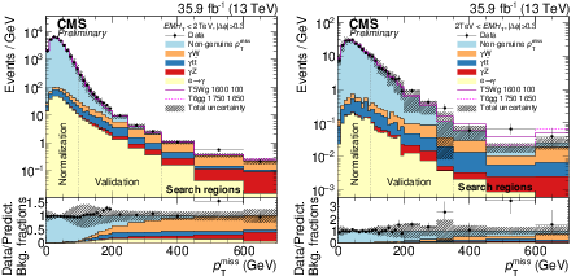
png pdf |
Figure 5:
Observed data compared to the background prediction. Two signal models are shown added to the background. The expectation for the T5Wg signal scenario with a gluino mass of 1600 GeV and a gaugino mass of 100 GeV and the T6gg signal scenario with a squark mass of 1750 GeV and a neutralino mass of 1650 GeV are shown added to the background. The low-(high-)$EM{H_{\mathrm {T}}} $ selection is shown on the left (right). Below the $ { {p_{\mathrm {T}}} ^\text {miss}} $ distributions, the data divided by the background prediction are shown as black dots, and the relative background components are shown as colored areas. |
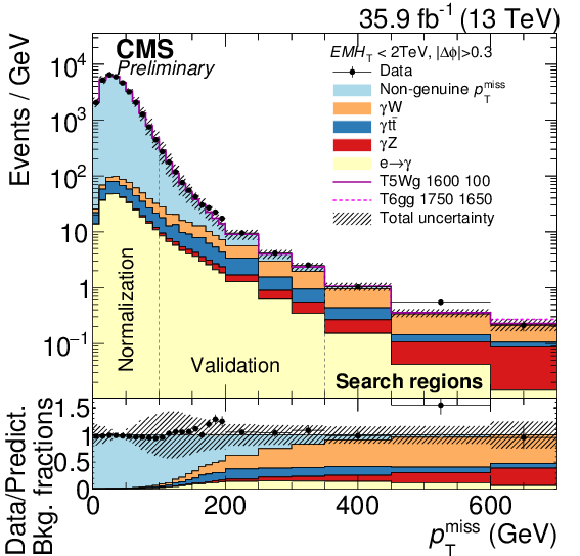
png pdf |
Figure 5-a:
Observed data compared to the background prediction. Two signal models are shown added to the background. The expectation for the T5Wg signal scenario with a gluino mass of 1600 GeV and a gaugino mass of 100 GeV and the T6gg signal scenario with a squark mass of 1750 GeV and a neutralino mass of 1650 GeV are shown added to the background. The low-$EM{H_{\mathrm {T}}} $ selection is shown. Below the $ { {p_{\mathrm {T}}} ^\text {miss}} $ distribution, the data divided by the background prediction are shown as black dots, and the relative background components are shown as colored areas. |
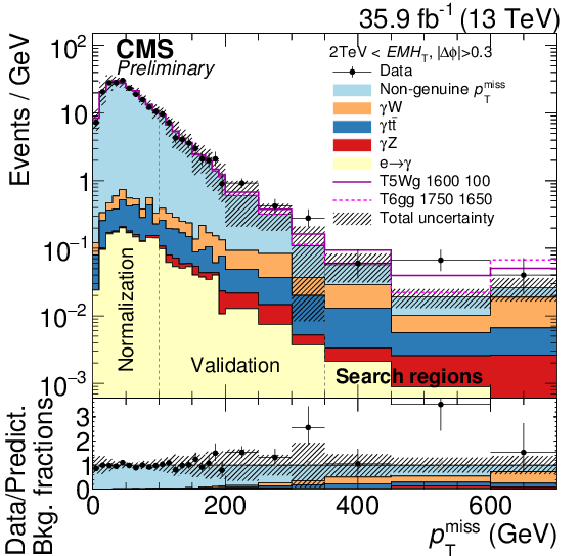
png pdf |
Figure 5-b:
Observed data compared to the background prediction. Two signal models are shown added to the background. The expectation for the T5Wg signal scenario with a gluino mass of 1600 GeV and a gaugino mass of 100 GeV and the T6gg signal scenario with a squark mass of 1750 GeV and a neutralino mass of 1650 GeV are shown added to the background. The high-$EM{H_{\mathrm {T}}} $ selection is shown. Below the $ { {p_{\mathrm {T}}} ^\text {miss}} $ distribution, the data divided by the background prediction are shown as black dots, and the relative background components are shown as colored areas. |
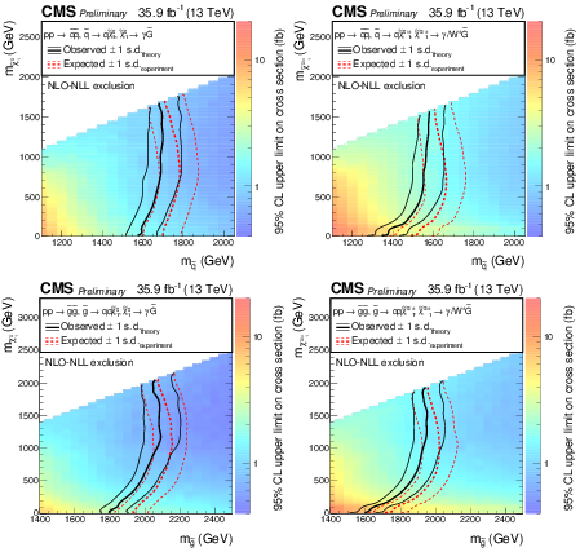
png pdf |
Figure 6:
Exclusion limits at 95% CL for T6gg (top left) T6Wg (top right), T5gg (bottom left) and T5Wg (bottom right) models. The solid black curve represents the observed exclusion contour and the uncertainty due to the signal cross section. The red dashed curves represent the expected exclusion contours and the experimental uncertainties. |
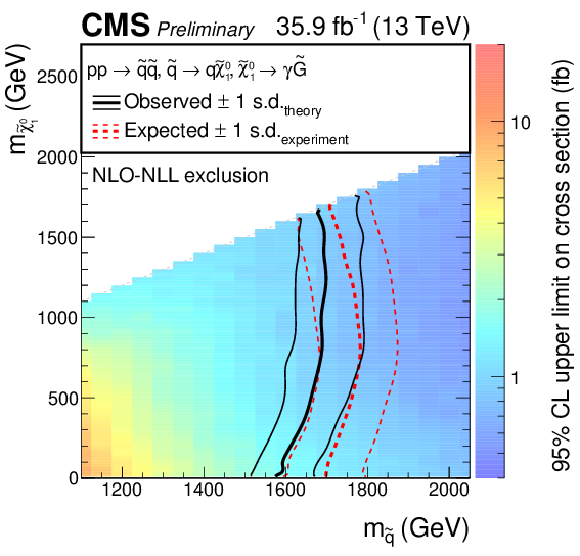
png pdf root |
Figure 6-a:
Exclusion limits at 95% CL for the T6gg model. The solid black curve represents the observed exclusion contour and the uncertainty due to the signal cross section. The red dashed curves represent the expected exclusion contours and the experimental uncertainties. |
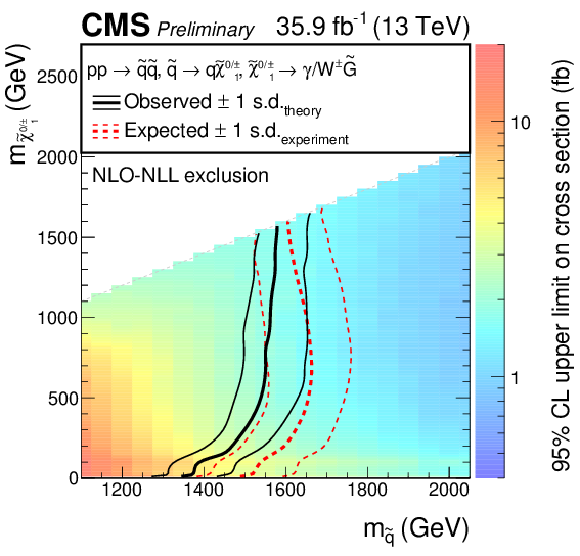
png pdf root |
Figure 6-b:
Exclusion limits at 95% CL for the T6Wg model. The solid black curve represents the observed exclusion contour and the uncertainty due to the signal cross section. The red dashed curves represent the expected exclusion contours and the experimental uncertainties. |
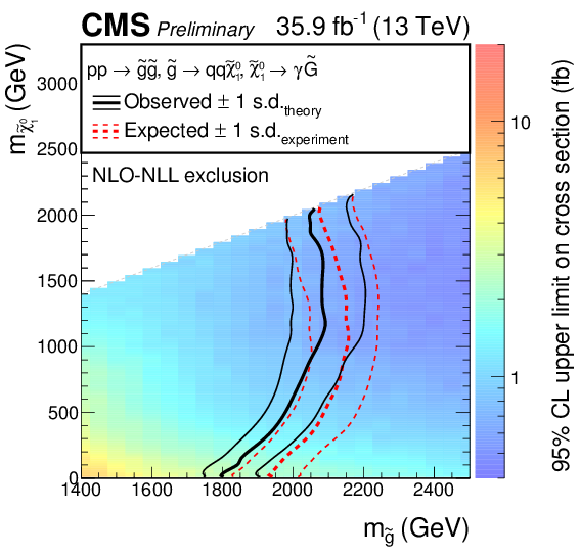
png pdf root |
Figure 6-c:
Exclusion limits at 95% CL for the T5gg model. The solid black curve represents the observed exclusion contour and the uncertainty due to the signal cross section. The red dashed curves represent the expected exclusion contours and the experimental uncertainties. |
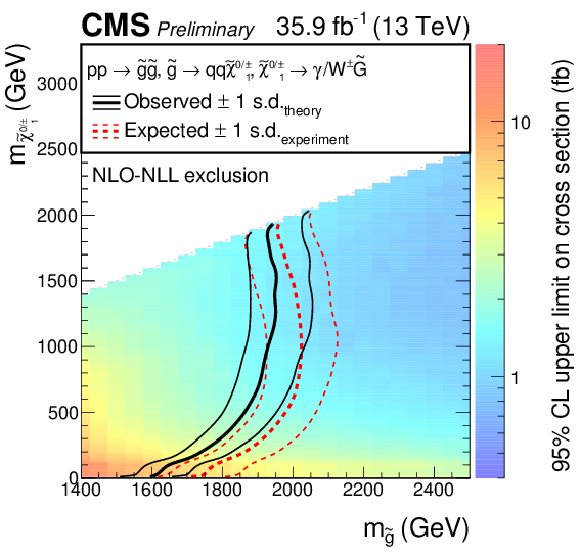
png pdf root |
Figure 6-d:
Exclusion limits at 95% CL for the T5Wg model. The solid black curve represents the observed exclusion contour and the uncertainty due to the signal cross section. The red dashed curves represent the expected exclusion contours and the experimental uncertainties. |
| Tables | |

png pdf |
Table 1:
Observed data compared to the background prediction and the expected signal yields for the T5Wg model with $m_{\tilde{g}}= $ 1600 GeV and $m_{gaugino}=$ 100 GeV. The quadratic sum of statistical and systematical uncertainties are given. Only experimental uncertainties for the signal model are stated. |
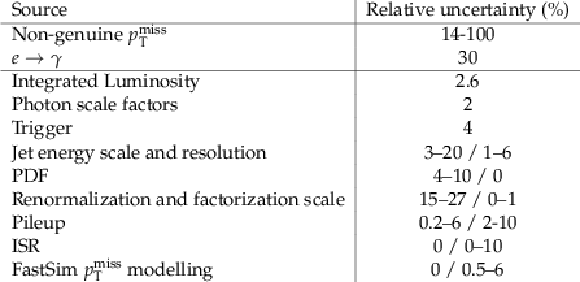
png pdf |
Table 2:
Systematic uncertainties for data-driven backgrounds (first two rows) and simulation (all other rows). If two values are given, the first one is for SM simulation, while the latter is for signal simulation. The PDF and scale uncertainty for signal simulation is for the shape only, as the uncertainty on the rate is considered by [34]. |
| Summary |
| A search for physics beyond the standard model in final states with at least one photon, transverse momentum imbalance, and total transverse event activity has been presented using data corresponding to an integrated luminosity of 35.9 fb$^{-1}$ of proton-proton collisions recorded by the CMS experiment at the LHC in 2016. The SM background is estimated from data and simulation, and is validated in several control regions. No signs of new physics beyond the SM are found, and the data are interpreted in simplified models motivated by GMSB. Gluino masses up to 2 TeV and squark masses up to 1.6 TeV are excluded. |
| Additional Figures | |
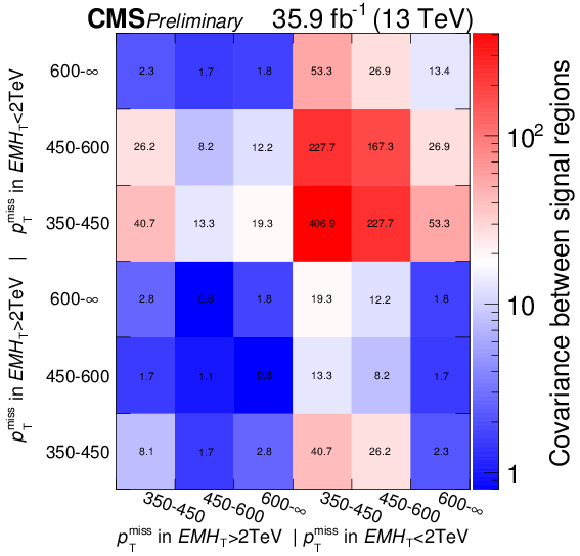
png pdf root |
Additional Figure 1:
Covariance between the search regions. |
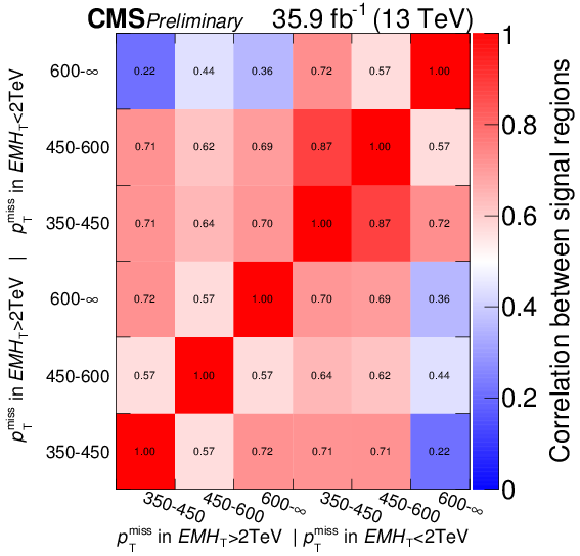
png pdf root |
Additional Figure 2:
Correlation between the search regions. |
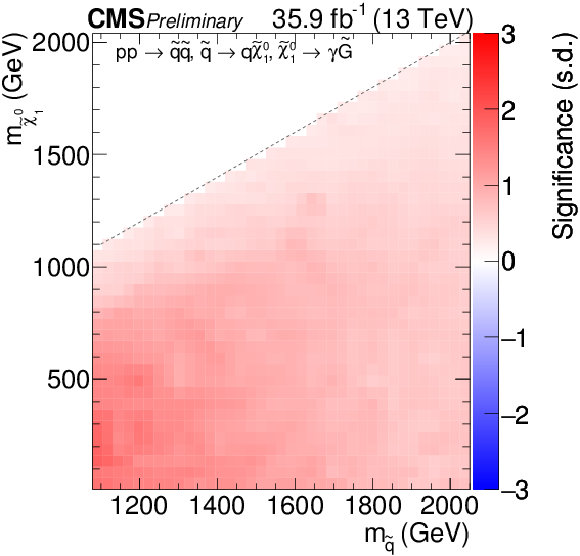
png pdf root |
Additional Figure 3:
Observed significance for T6gg model. |
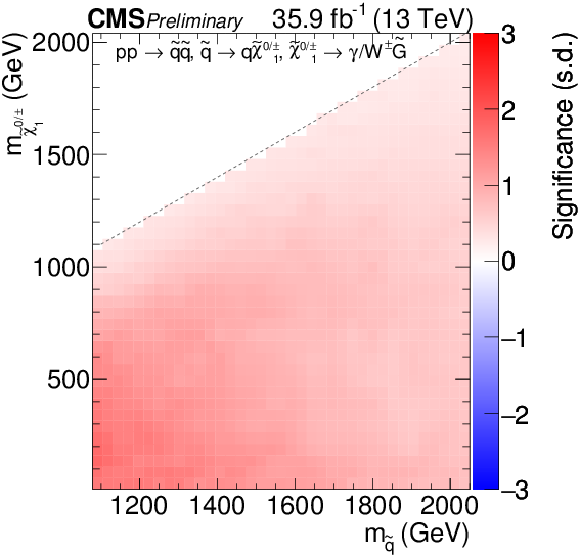
png pdf root |
Additional Figure 4:
Observed significance for T6Wg model. |
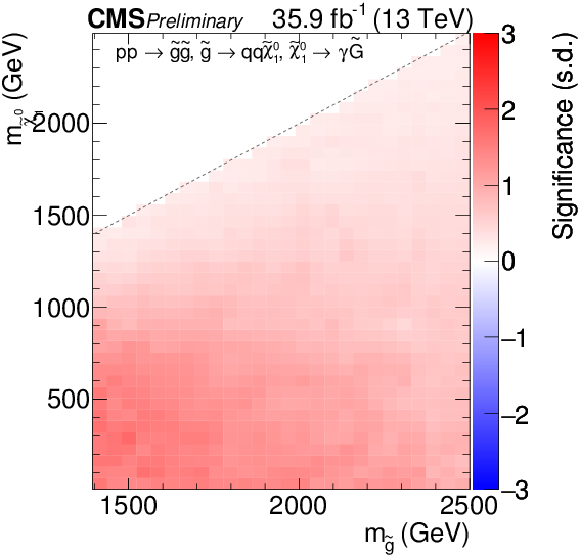
png pdf root |
Additional Figure 5:
Observed significance for T5gg model. |
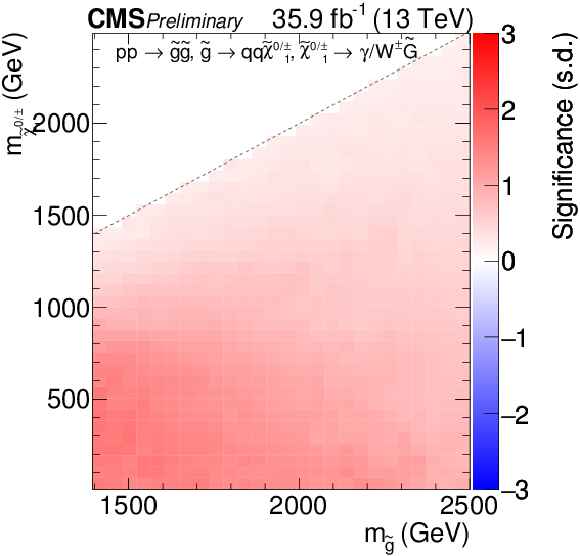
png pdf root |
Additional Figure 6:
Observed significance for T5Wg model. |
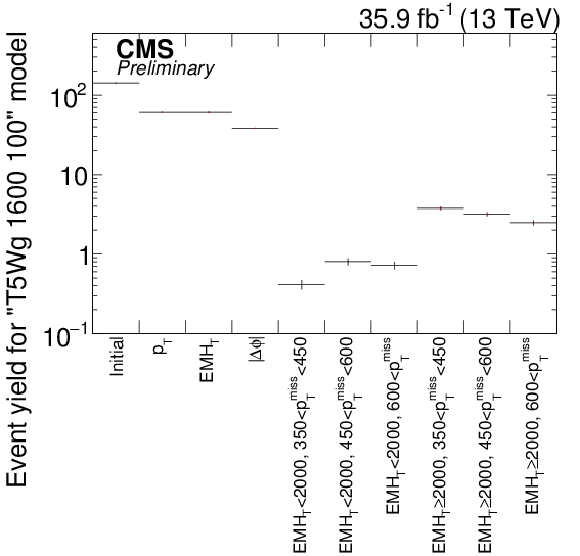
png pdf root |
Additional Figure 7:
Signal yield after several analysis cuts for the T6Wg model with a gluino mass of 1600 GeV and a gaugino mass of 100 GeV. The number of events which would have been produced in the collisions is given in the first bin. The second bin contains events, in which a reconstructed photon with the criteria defined in the analysis is reconstructed. The third bin contains events which have $ EM {H_{\mathrm {T}}} > $ 700 GeV in addition to a photon. In nearly all events of this model, $EM {H_{\mathrm {T}}} $ exceeds 700 GeV. The fourth bin contains events with a reconstructed photon, $ EM {H_{\mathrm {T}}} > $ 700 GeV, and $|\Delta \phi (\pm { {p_{\mathrm {T}}} ^\text {miss}} , {p_{\mathrm {T}}} ^{\gamma })|> $ 0.3. The last six bins are the event yields in the search regions. |
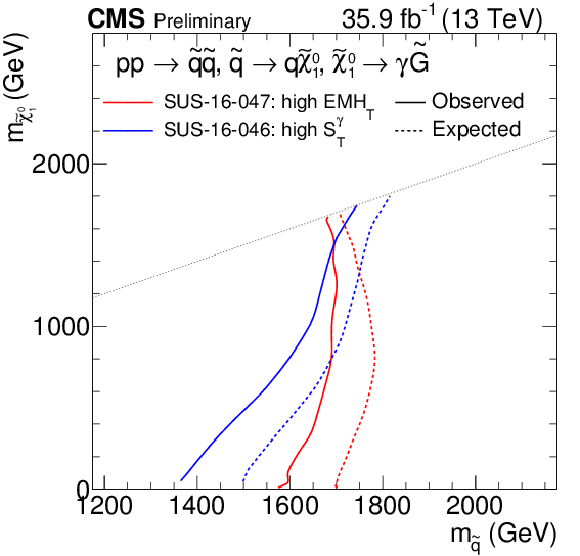
png pdf |
Additional Figure 8:
Observed and expected exclusion contours for SUS-16-047 (this analysis) and SUS-16-046 for the T6gg model. |
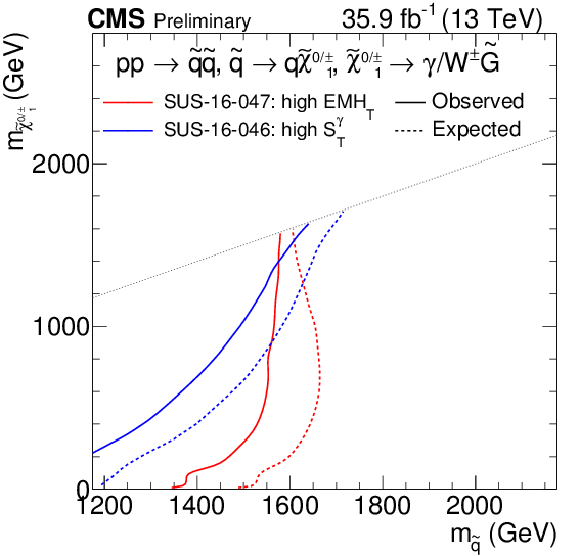
png pdf |
Additional Figure 9:
Observed and expected exclusion contours for SUS-16-047 (this analysis) and SUS-16-046 for the T6Wg model. |
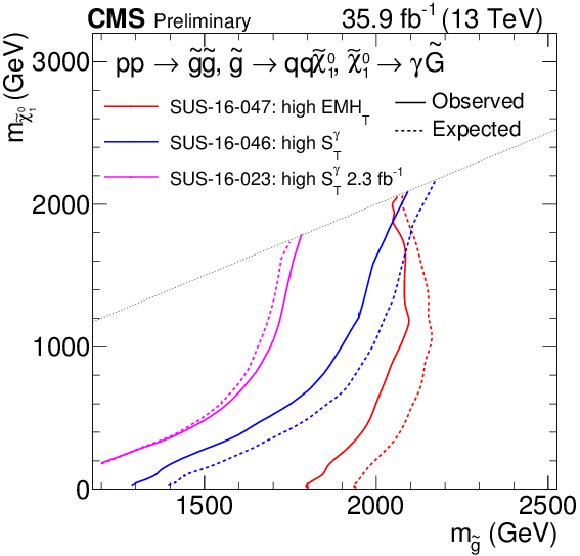
png pdf |
Additional Figure 10:
Observed and expected exclusion contours for SUS-16-047 (this analysis), SUS-16-046, and SUS-16-023 for the T5gg model. |
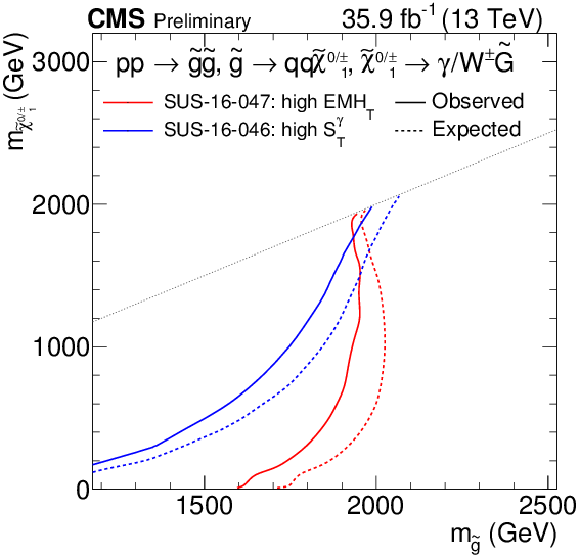
png pdf |
Additional Figure 11:
Observed and expected exclusion contours for SUS-16-047 (this analysis) and SUS-16-046 for the T5Wg model. |
| References | ||||
| 1 | R. Barbieri and G. F. Giudice | Upper bounds on supersymmetric particle masses | Nucl. Phys. B 306 (1988) 63 | |
| 2 | P. Ramond | Dual theory for free fermions | PRD 3 (1971) 2415 | |
| 3 | Y. A. Gol'fand and E. P. Likhtman | Extension of the algebra of Poincare group generators and violation of P invariance | JEPTL 13 (1971) 323 | |
| 4 | S. Ferrara and B. Zumino | Supergauge Invariant Yang-Mills Theories | Nucl. Phys. B 79 (1974) 413 | |
| 5 | J. Wess and B. Zumino | Supergauge transformations in four-dimensions | Nucl. Phys. B 70 (1974) 39 | |
| 6 | A. H. Chamseddine, R. L. Arnowitt, and P. Nath | Locally supersymmetric grand unification | PRL 49 (1982) 970 | |
| 7 | R. Barbieri, S. Ferrara, and C. A. Savoy | Gauge models with spontaneously broken local supersymmetry | PLB 119 (1982) 343 | |
| 8 | L. J. Hall, J. D. Lykken, and S. Weinberg | Supergravity as the messenger of supersymmetry breaking | PRD 27 (1983) 2359 | |
| 9 | P. Fayet | Mixing between gravitational and weak interactions through the massive gravitino | PLB 70 (1977) 461 | |
| 10 | H. Baer, M. Brhlik, C.-h. Chen, and X. Tata | Signals for the minimal gauge-mediated supersymmetry breaking model at the Fermilab Tevatron collider | PRD 55 (1997) 4463 | hep-ph/9610358 |
| 11 | H. Baer, P. G. Mercadante, X. Tata, and Y. Wang | Reach of Fermilab Tevatron upgrades in gauge-mediated supersymmetry breaking models | PRD 60 (1999) 055001 | hep-ph/9903333 |
| 12 | S. Dimopoulos, S. Thomas, and J. D. Wells | Sparticle spectroscopy and electroweak symmetry breaking with gauge-mediated supersymmetry breaking | Nucl. Phys. B 488 (1997) 39 | hep-ph/9609434 |
| 13 | J. Ellis, J. L. Lopez, and D. V. Nanopoulos | Analysis of LEP constraints on supersymmetric models with a light gravitino | PLB 394 (1997) 354 | hep-ph/9610470 |
| 14 | M. Dine, A. E. Nelson, Y. Nir, and Y. Shirman | New tools for low energy dynamical supersymmetry breaking | PRD 53 (1996) 2658 | hep-ph/9507378 |
| 15 | G. F. Giudice and R. Rattazzi | Gauge-mediated supersymmetry breaking | in Perspectives on Supersymmetry, p. 355 World Scientific, Singapore | |
| 16 | P. Grajek, A. Mariotti, and D. Redigolo | Phenomenology of General Gauge Mediation in light of a 125 GeV Higgs | JHEP 07 (2013) 109 | 1303.0870 |
| 17 | R. Barbier et al. | R-parity-violating supersymmetry | Phys. Rep. 420 (2005) 1 | hep-ph/0406039 |
| 18 | G. R. Farrar and P. Fayet | Phenomenology of the production, decay, and detection of new hadronic states associated with supersymmetry | PLB 76 (1978) 575 | |
| 19 | CMS Collaboration | Search for supersymmetry with photons in $ pp $ collisions at $ \sqrt{s} = $ 8 TeV | PRD 92 (2015) 072006 | |
| 20 | ATLAS Collaboration | Search for photonic signatures of gauge-mediated supersymmetry in 8 TeV pp collisions with the ATLAS detector | PRD 92 (2015) 072001 | 1507.05493 |
| 21 | ATLAS Collaboration | Search for supersymmetry in a final state containing two photons and missing transverse momentum in $ \sqrt{s} $ = 13 TeV $ pp $ collisions at the LHC using the ATLAS detector | EPJC 76 (2016) 517 | 1606.09150 |
| 22 | CMS Collaboration | Search for supersymmetry in electroweak production with photons and large missing transverse energy in pp collisions at $ \sqrt{s} = $ 8 TeV | PLB 759 (2016) 479--500 | CMS-SUS-14-016 1602.08772 |
| 23 | CMS Collaboration | Search for supersymmetry in events with photons and missing transverse energy in pp collisions at 13 TeV | Submitted to: PLB (2016) | CMS-SUS-15-012 1611.06604 |
| 24 | CMS Collaboration | Performance of photon reconstruction and identification with the CMS detector in proton-proton collisions at $ \sqrt{s} = $ 8 TeV | JINST 10 (2015) P08010 | |
| 25 | CMS Collaboration | Jet energy scale and resolution in the CMS experiment in pp collisions at 8 TeV | JINST 12 (2017) P02014 | CMS-JME-13-004 1607.03663 |
| 26 | CMS Collaboration | The CMS experiment at the CERN LHC | JINST 3 (2008) S08004 | CMS-00-001 |
| 27 | CMS Collaboration | Particle--Flow Event Reconstruction in CMS and Performance for Jets, Taus, and $ E_{\mathrm{T}}^{\text{miss}} $ | CDS | |
| 28 | CMS Collaboration | Commissioning of the Particle-flow Event Reconstruction with the first LHC collisions recorded in the CMS detector | CDS | |
| 29 | M. Cacciari, G. P. Salam, and G. Soyez | The anti-$ k_t $ jet clustering algorithm | JHEP 04 (2008) 063 | 0802.1189 |
| 30 | M. Cacciari, G. P. Salam, and G. Soyez | FastJet User Manual | EPJC 72 (2012) 1896 | 1111.6097 |
| 31 | J. Alwall et al. | The automated computation of tree-level and next-to-leading order differential cross sections, and their matching to parton shower simulations | JHEP 07 (2014) 079 | 1405.0301 |
| 32 | NNPDF Collaboration | Parton distributions for the LHC Run II | JHEP 04 (2015) 040 | 1410.8849 |
| 33 | T. Sjostrand, S. Mrenna, and P. Z. Skands | A Brief Introduction to PYTHIA 8.1 | CPC 178 (2008) 852 | 0710.3820 |
| 34 | C. Borschensky et al. | Squark and gluino production cross sections in pp collisions at $ \sqrt{s} = $ 13, 14, 33 and 100 TeV | EPJC 74 (2014) 3174 | 1407.5066 |
| 35 | CMS Collaboration | Interpretation of Searches for Supersymmetry with simplified Models | PRD 88 (2013) 052017 | CMS-SUS-11-016 1301.2175 |
| 36 | GEANT4 Collaboration | GEANT4: A Simulation toolkit | NIMA 506 (2003) 250 | |
| 37 | CMS Collaboration, S. Sekmen | Recent Developments in CMS Fast Simulation | in Proceedings, 38th International Conference on High Energy Physics (ICHEP 2016): Chicago, IL, USA, August 3-10, 2016 2017 | 1701.03850 |
| 38 | A. L. Read | Presentation of search results: the $ CL_s $ technique | JPG 28 (2002) 2693 | |
| 39 | T. Junk | Confidence level computation for combining searches with small statistics | NIMA 434 (1999) 435 | hep-ex/9902006 |
| 40 | ATLAS Collaboration, CMS Collaboration, LHC Higgs Combination Group | Procedure for the LHC Higgs boson search combination in Summer 2011 | CMS-NOTE-2011-005 | |
| 41 | G. Cowan, K. Cranmer, E. Gross, and O. Vitells | Asymptotic formulae for likelihood-based tests of new physics | EPJC 71 (2011) 1554 | 1007.1727 |
| 42 | CMS Collaboration | Simplified likelihood for the re-interpretation of public CMS results | CDS | |

|
Compact Muon Solenoid LHC, CERN |

|

|

|

|

|

|